|
The
Concept of God in the Vedas
Swami
Tattwamayananda
(Continued
from the previous issue)
From
Many to One
At
the earlier stages of spiritual evolution and metaphysical
thought the Vedas mention the names of various gods and goddesses:
Mitra, the Sun; Varuna, the god of night and of the blue sky;
Dyu and Prithivi, the Sky and the Earth; Agni or fire god,
the friend of all; Savitri, the Refulgent; Indra, the master
of the universe; Vishnu (though not a major divinity in the
Rig Veda), the measurer of the three worlds; and Aditi, the
mother of all other gods (the Adityas).
Gradually,
however, we come across a tendency towards extolling a god
as the greatest, controlling all other divine entities. This
marks the progress of man’s concept of God or the ultimate
Reality from polytheism to monotheism, ultimately leading
to monism. That is why the Rig Vedic rishi asks: ‘Kasmai
devaya havisha vidhema? To what god shall we offer our
oblations?’ (1) And again, ‘Ko dadarsha prathamam jayamanam?
Who saw the first-born?’ (1.164.4)
The
first mandala of the Rig Veda brings out this idea most beautifully:
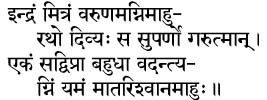
‘They
(the men of wisdom) call him Indra, Mitra, Varuna, Agni, and
he is the heavenly, noble-winged Garutman. The Reality is
one, but sages call it by many names; they call it Agni, Yama,
Matarishvan (and so on).’ (1.164.46)
The
idea that names may be many and different but they all denote
the one God occurs in ‘Vishvakarma Sukta’ too. Therein it
is stated:

‘The
name-giver of the gods is one; other beings come to him to
inquire.’ (10.82.3)
Samprashnam
here refers to the two questions from the ‘Nasadiya Sukta’:
‘Kah veda? Who had known?’ and ‘Kah pravocad?
Who had announced?’ These questions, which are in fact an
enquiry into the one impersonal, attributeless, formless Principle
behind all concepts of God, occur in the ‘Hiranyagarbha Sukta’
(10.121, cited above), in the Shatapatha Brahmana (‘Ko
hi prajapatih? Who is Prajapati?’), and also in the Aitareya
Brahmana (‘Ko nama prajapatirabhvat? Who became
Prajapati?’)
One
of the grandest conceptions of God in the whole of Vedic literature
is found in the last chapter of the Shukla Yajur Veda Samhita,
which is known as the Ishavasya Upanishad. It is said
that whatever there is in this world is to be filled and covered
with isha or Ishvara (ishavasyamidam sarvam).
God creates this world, then enters into everything. The idea
is put forward even more forcefully in the Taittiriya Upanishad:

‘It
created all this that exists. Having created (that) It entered
therein. Having entered, It became the formed and the formless.’
(2)
The
Upanishad says that ‘It’ contemplated and projected (created)
the universe, and then entered into the created objects and
became one with both the manifest, gross and concrete creation
as well as the unmanifest, subtle and abstract.
The
universe is the abode of God. The Lord is the ruler of the
universe as well as its indweller. The various aspects of
gods and goddesses exist within the body of this Lord in their
subtle and causal forms. At this stage He is called Prajapati
or Hiranyagarbha. The concepts of Prajapati (the supreme Lord
of all beings) and Vishvakarma (the Creator in instrumental
mode) constitute an important stage in the conception of God
in the Rig Veda. The idea of a great deity who is the repository
of all power and virtue was a gradual and natural process
of growth.
Prithvi
is the feet of this Lord; antariksha is his belly;
dyu his head; the Sun and the Moon are his eyes; different
corners of the universe are his ears. The microcosm and the
macrocosm are the two dimensions of the same Ishvara. The
concept of Prajapati or Hiranyagarbha marks an advanced state
of monotheistic evolution of Vedic philosophy. The question
repeatedly raised in the famous ‘Hiranyagarbha Sukta’, ‘Kasmai
devaya havisha vidhema?’ shows that polytheistic conceptions
of the Godhead had been left behind by then.
Anthropomorphism
at an advanced monotheistic level is revealed in the ‘Purusha
Sukta’, which is widely used in a number of rituals. The sukta
says: ‘Purusha evedam sarvam, yadbhutam yacca bhavyam;
Purusha is all this world of movable and immovable objects.
He constitutes the past, the present and also the future.’
The
Purusha of the ‘Purusha Sukta’ is the manifested state of
unmanifested karana brahman. Possessed of an infinite
number of heads, eyes and feet, he has enveloped the whole
of his creation. He manifests as virat, the sum total
of all existence. Depicting the macrocosmic dimension of creation,
he reminds us of the essential unity and oneness of existence,
the unity of God and His creation. The ‘Hiranyagarbha Sukta’
announces: ‘Hiranyagarbhah samavartatagre bhutasya jatah
patireka asit; Hiranyagarbha was present at the beginning;
when born, he was the sole lord of created beings.’ (10.121)
From this stage it is only a small step to the Advaitic concept
of an ultimate Reality without name, form or attributes.
The
Concept of God and Rita
Rita
is the cosmic order that guides not only the individual life
of man, but also the totality of universal life. So, a god
is sometimes called ritavan and a goddess ritavati.
The god Varuna is supposed to be the custodian of rita,
which, according to Vedic seers, is praised and glorified
even by the devas. The Rig Veda calls Vishnu ritasya
garbha, the embryo of rita. The dawn, the sun,
the moon, in fact the entire universe, is based on rita.
The twenty-third sukta of the fourth Rig Vedic mandala, addressed
to the god Indra, ends with the glorification of rita.
As a moral principle it encompasses the psychological life
of individuals. As the cosmic Order or eternal Law it is responsible
for the triumph of good over evil and light over darkness.
Rita integrates chaos into cosmos, gives order to the
universe and shows the righteous path for the mind to follow.
It is the psychological principle teaching man how to lead
a moral life. Thus we can see that according to the Vedic
seers, the same ideal functions as the guiding principle for
individual as well as universal life. That is why in the first
sukta of the Rig Veda itself, addressed to Agni, the sages
call their deity ritasya didivim, the illuminator
of truth.
The
Concept of Self-surrender in Vedic Literature
It
may be interesting to note here that even the concept of prapatti
or sharanagati (the path of self-surrender through
total subservience to God), usually associated with the bhakti
tradition, has its origin in the Vedas. This supreme ideal
of devotion consists of six factors:

‘A
sattvic motive, abstinence from all kinds of disservice to
God, conviction and unflinching faith in the saving grace
of the Lord, seeking His grace, complete self-offering, and
longing for the earliest extinction of this worldly existence
constitute the six forms of self-surrender.’ (3)
The
‘Varuna Sukta’ found in the seventh mandala of the Rig Veda
is, perhaps, the origin of the ideal of self-surrender which
later became an essential element of Vaishnavism. In the first
four mantras the rishi is repeatedly asking Varuna to have
mercy on him, to bestow joy and happiness on him. He is craving
for mercy and favour:

‘May
I never go, royal Varuna, to a house made of clay; have mercy,
Almighty, have mercy.’ (Rig Veda 7.89.1)
The
word nyasa is often used to mean the sharanagati
ideal that is normally denoted by prapatti in Vaishnava
devotional scriptures. For example, it is said in the Taittiriya
Aranyaka that self-surrender is the highest form of
austerity: ‘Etanyavarani tapamsi nyasa evatyarecayat.’
(4) It is also stated that, ‘nyasa iti brahma, brahma hi
parah; renunciation is Brahma, and Brahma is the Supreme.’
(5)
Some
of the Vedic statements, which form the origin of the six
elements of the sharanagati ideal, may be identified
as follows:
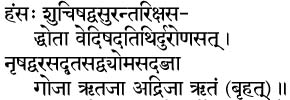
‘He
is the sun dwelling in the heavens, the air dwelling in the
sky, Vasu (the appointer of the stations of all creatures)
in the mid region, the fire existing in the altar (the agni
on earth), the guest in the house; He dwells among men, among
the gods, in Truth and in space. He is born in water, born
on earth, born in the sacrifice, and born in the mountains.
He is the Truth. (He is the Great One.)’ (6)
The
idea of sattvic motives, anukulyasya sangkalpa, that
is reflected in the pervasive vision of the Supreme in the
above mantra, has been expressed even more forcefully in the
Rig Vedic shanti mantra beginning ‘Vangme manasi pratishthita
mano me vaci pratishthitam; May my speech be based on
(be in accord with) my mind; may my mind be based on my speech.’
The
ideal of complete abstinence from all types of negative action
or disservice (pratikulyasya varjanam) is indicated
in the Rig Vedic mantra:

Saviour
gods, speak favourably to us; let not sleep, nor the censurer
overpower us.’ (8.48.14)
Similarly,
different aspects of the ideal of sharanagati are found
in the following Vedic mantras:
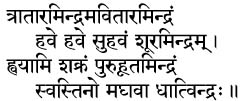
‘I
invoke, at repeated sacrifices, Indra, the preserver, the
protector, the hero, who is easily propitiated - Indra, the
powerful, invoked by many. May Indra, the lord of affluence,
bestow prosperity upon us.’ (7) (Faith in the saving grace
of God.)

‘O
Bounteous One! You are our father and mother.’ (8)

O
Indra, with you as our helper, let us answer our enemies.
You are ours and we yours.’ (9)
The
well-known shanti mantra of the Krishna Yajur Veda
beginning with ‘Saha navavatu; May He protect us’,
reflects the soul’s yearning to take refuge in God, goptritva-varanam.
Offering
prayers, performing Vedic rituals to various gods and goddesses
and leading an integrated life of pursuit of the path of artha
and kama without deviating from the path of dharma, in complete
harmony with nature and the rest of creation - this was the
guiding ethical principle of Vedic society. To understand
the idea of God conceived at the early stages of Vedic thought,
it is essential to take note of certain fundamental features
of the Vedic scheme of life. The social life portrayed in
Rig Veda reveals certain interesting features. Monogamy, sanctity
of the institution of marriage, domestic purity, a patriarchal
system, a just and equitable law of sacrifice, and high honour
for women were some of the noteworthy features of the social
life during the Vedic period. We find the Vedic seers praying
for fullness of life:

‘May
we see the sun rise a hundred autumns. May we live a hundred
autumns, hear (through) a hundred autumns, speak (through)
a hundred autumns, and be happy and contented a hundred autumns,
nay, even beyond these years.’ (10)
The
Origin of Advaita
In
the Bhagavadgita, Sri Krishna himself says that those who
are devoid of proper knowledge of the real purport of the
Vedas and the proper method of propitiating the Almighty,
are deluded by ignorance. They think that they themselves
are capable of performing Vedic sacrifices, even without the
help or grace of God. (11)
One
of the most striking depictions of the relation between the
macrocosm and the microcosm, the absolute and the relative,
the ultimate cause and its effect (karana brahma and
karya brahma) and the assertion that both are, in reality,
infinite, full and perfect, occurs towards the end of the
Shukla Yajur Veda Samhita in the shanti mantra for
the Ishavasya Upanishad beginning with ‘Purnamadah
purnamidam; That (supreme Brahman) is infinite, and this
(conditioned Brahman) is infinite.’
Several
portions of the Shukla Yajur Veda Samhita (for instance,
the ‘Rudradhyaya’) contain ideas that are strikingly Advaitic
in content and form. Some mantras of the ‘Purusha Sukta’ (which
occurs in the Shukla Yajur Veda as well) are interpreted
even by Sayanacharya in Advaitic terms. Commenting on the
mantra beginning with ‘Paridyava prithivi sadya itva parilokan
paridishah parisvah; Having gone swiftly round the earth
and heaven, around the worlds, around the sky, around the
quarters’, Sayana states: ‘Here the nature of jiva is Brahman.’
(12)
Similarly,
the Krishna Yajur Veda Samhita too is full of mantras
which have an Advaitic content. The Tandya Brahmana
and the Samavidhana of the Sama Veda are equally rich
in Advaitic ideas. So also the Atharva Veda.
The
literal meaning of Advaita has been explained by Madhusudana
Saraswati as ‘that in which there is no twofoldness’. Shankara’s
Advaita siddhanta is not only the climax of philosophical
speculation and the highest philosophy of ethics, but also
a way of life. As the culmination of man’s metaphysical contemplation
and spiritual evolution it is the natural final goal of our
spiritual sadhanas. In fact, some of the most beautiful Upanishadic
verses which Shankara has interpreted in the light of Advaita
occur in the Samhita portion of the Rig Veda. For example,
the following mantra traditionally associated with the Mundaka
Upanishad (3.1.1) is found in the Rig Veda as well:
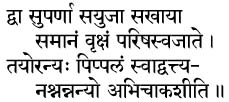
‘Two
birds that are ever associated and have similar names, cling
to the same tree. Of these, one eats the fruits of divergent
tastes, and the other looks on without eating.’ (13)
The
mantra brings out the essence of Advaita philosophy and the
identity of jiva and Brahman. The bird on the lower branch
is the jiva and the one sitting on the upper branch of the
tree as witness, without eating fruits, is God Himself. This
mantra shows that though its philosophical and logical perfection
is reached in Upanishadic literature, the origin of Advaita
philosophy is, in fact, to be found in the Rig Veda Samhita
itself.
The
well-known ‘Devi Sukta’ (10.125) is another striking example
of a Samhita mantra depicting Advaitic experience. The word
cikitushi in the third mantra of this sukta is explained
by Sayana as:

’She
(the rishi) had known or realized as her own Self the supreme
Brahman, that which must be realized.’
Innumerable
mantras of the Rig Veda Samhita have been explained
by Sayana in an exclusively Advaitic sense.
The
Rig Veda gives a great message in the first mantra of the
thirteenth sukta of the tenth mandala. This is perhaps the
most forceful expression of man’s divinity and immortality
found in the whole of Vedic literature. It runs as follows:
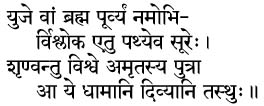
‘O
my sense organs and their presiding deities, I salute you
(that is, I merge you all with the eternal Brahman through
meditation). May this hymn of praise spread everywhere through
the medium of the wise. May you all, children of immortal
Bliss, and all those living in the bright (divine) worlds,
listen to me!’
The
famous ‘Nasadiya Sukta’ (Rig Veda 10.129) contains the most
sublime depiction of Advaitic monism that was later elaborated
upon in the Upanishads and expounded by the great Shankaracharya.
In this hymn all phenomena are traced to the one Principle
which is beyond opposites like life and death, existence and
non-existence, being and nonbeing, day and night, and so
on. The one Reality is neither existence nor non-existence;
it is beyond name and definition. The concept of maya, which
explains why the perfect Reality appears as this imperfect
world, has its roots in the ‘Nasadiya Sukta’. Here we may
very well remember that Advaita is, after all, a matter of
inner experience (‘anubhavaikavedyam; known through
experience alone’, in the language of Shankaracharya) and
not a subject for philosophical speculation.
The
‘Nasadiya Sukta’ is perhaps the most scientific description
of the ultimate Reality as well as of the projection of the
phenomenal world. It makes the relative and the Absolute,
nature and Spirit, the twin aspects of that one Reality and
shows that men of wisdom (kavayah), who had controlled
their senses, found out the ultimate cause of this world (which
appears to be real) in their own hearts (hridi) through
concentrated intellects (manisha).
References
1.
Rig Veda, 10.121.
2.
Taittiriya Upanishad, 2.6.1.
3.
Ahirbudhnya Samhita, 37.28.
4.
Taittiriya Aranyaka, 10.62.
5.
Ibid.
6.
Rig Veda, 4.40.5.
7.
Rig Veda, 6.47.11; Atharva Veda, 7.86.1.
8.
Rig Veda, 7.98.11; Atharva Veda, 20.108.2.
9.
Rig Veda, 8.92.32.
10.
Shukla Yajur Veda, 36.24.
11.
See Ramanuja’s commentary on Bhagavadgita, 15.15.
12.
Sayanacharya’s commentary on Shukla Yajur Veda, 32.12.
13.
Rig Veda, 1.164.20.
|
